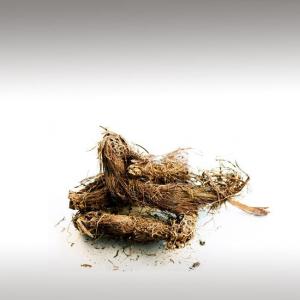
NARD ESSENTIAL OIL (NARDOSTACHYS JATAMANSI) - ESSENTIAL OILS

BASE / GENERAL DATA
Information submited: March 5, 2015 Modified: March 15, 2018 By: OperaDreamhouse
Botanical Name: Nardostachys grandiflora
Common Method of Extraction: Nardostachys jatamansi Syn. Nardostachys grandiflora
Part Typically Used: Rhizomes, roots
Color: Amber, dark, black
Consistency: Very thick
Perfumery Note: Base
Other names: Jatamansi, Spikenard, Nardostachys Jatamansi
Strength of Initial Aroma: Woody fragrance which is astonishingly herbaceous and aromatic, warm and sensual, also a combination of sweet, resinous, spicy, and animal-fat odors.
The Nard essential oil is like an organic earthy scent. It's earthy, scent is said to please the earth spirits. Commonly burned as incense among Himalayan dwellers to calm and sanctify the environment. Jatamansi oil has a strong fragrance of moist earth, like the high altitude forest floor where it is found, and the distinct odor of the valerianaceae family.
Nardostachys is a Persian word referring to the Nard plant. "Jatamansi"comes from the Sanskrit name from where it is found in India.
Spikenard essentail oil also called nard, nardin, and muskroot, is a class of aromatic amber-colored essential oil derived from flowering plants, the identification of which is variable. The oil has, since ancient times, been used as a perfume, as a medicine and in religious contexts, across a wide territory from India to Europe.
Nardostachys is found to occur between 3,300 and 6,000 m in the Himalayas: Kashmir (India), Uttar Pradesh (India), Nepal, Sikkim (India), Bhutan, South-West China including Tibet, Yunnan and southwest Sichuan. In nature, the plant is generally found clinging to steep rocky cliffs, stony and grassy slopes, and is rarely found as lithophytes. It is also reported from ravines of the rocks and crevices, small depressions, somewhat found in wet meadows and by the banks of the rivulets in the high valleys and peaks ranging from 3,000 - 4,000 m.
Nardostachys jatamansi (Jatamansi) is a perennial herb. It has a stout un-branched or sparsely-branched woody aromatic rhizome, covered with reddish-brown thick fibers of remnants, a petiole of withered radical leaves with a single long tap root, typically with 2-7 rhizomes but sometimes up to 15. The thickness and numbers ofrhizomes per plant depends on the age of plant.
Nard is one of the ancient incense utilized by the Egyptians. A description of Spikenard is also mentioned in the Song of Solomon in the Holy Bible. “While the king sitteth at his table, my Spikenard sendeth forth the smell thereof". The essential oilwas also used by Roman perfumers. The oil was used by Roman perfumers and the Mughal empress Nur Jehan in her rejuvenating cosmetics preparations
Nard was one of the early aromatics used by the ancient Egyptians and is mentioned in the Bible in Song of Solomon, and in the Book of John where Mary used it to anoint the feet of Jesus.
Chemical strukture:
Rhizomes, rich in sesquiterpenoides, yield jatamanshic acid, jatamansone, patchouli alcohol, nor-seychelanone, seychellen, and alpha and beta patchoulene. The essential oil yields several hydrocarbons, a new oxide, beta-cudesmol, elemol, angelicin and jatamansinol.
Common Method of Extraction: Nardostachys jatamansi Syn. Nardostachys grandiflora
Part Typically Used: Rhizomes, roots
Color: Amber, dark, black
Consistency: Very thick
Perfumery Note: Base
Other names: Jatamansi, Spikenard, Nardostachys Jatamansi
Strength of Initial Aroma: Woody fragrance which is astonishingly herbaceous and aromatic, warm and sensual, also a combination of sweet, resinous, spicy, and animal-fat odors.
The Nard essential oil is like an organic earthy scent. It's earthy, scent is said to please the earth spirits. Commonly burned as incense among Himalayan dwellers to calm and sanctify the environment. Jatamansi oil has a strong fragrance of moist earth, like the high altitude forest floor where it is found, and the distinct odor of the valerianaceae family.
Nardostachys is a Persian word referring to the Nard plant. "Jatamansi"comes from the Sanskrit name from where it is found in India.
Spikenard essentail oil also called nard, nardin, and muskroot, is a class of aromatic amber-colored essential oil derived from flowering plants, the identification of which is variable. The oil has, since ancient times, been used as a perfume, as a medicine and in religious contexts, across a wide territory from India to Europe.
Nardostachys is found to occur between 3,300 and 6,000 m in the Himalayas: Kashmir (India), Uttar Pradesh (India), Nepal, Sikkim (India), Bhutan, South-West China including Tibet, Yunnan and southwest Sichuan. In nature, the plant is generally found clinging to steep rocky cliffs, stony and grassy slopes, and is rarely found as lithophytes. It is also reported from ravines of the rocks and crevices, small depressions, somewhat found in wet meadows and by the banks of the rivulets in the high valleys and peaks ranging from 3,000 - 4,000 m.
Nardostachys jatamansi (Jatamansi) is a perennial herb. It has a stout un-branched or sparsely-branched woody aromatic rhizome, covered with reddish-brown thick fibers of remnants, a petiole of withered radical leaves with a single long tap root, typically with 2-7 rhizomes but sometimes up to 15. The thickness and numbers ofrhizomes per plant depends on the age of plant.
Nard is one of the ancient incense utilized by the Egyptians. A description of Spikenard is also mentioned in the Song of Solomon in the Holy Bible. “While the king sitteth at his table, my Spikenard sendeth forth the smell thereof". The essential oilwas also used by Roman perfumers. The oil was used by Roman perfumers and the Mughal empress Nur Jehan in her rejuvenating cosmetics preparations
Nard was one of the early aromatics used by the ancient Egyptians and is mentioned in the Bible in Song of Solomon, and in the Book of John where Mary used it to anoint the feet of Jesus.
Chemical strukture:
Rhizomes, rich in sesquiterpenoides, yield jatamanshic acid, jatamansone, patchouli alcohol, nor-seychelanone, seychellen, and alpha and beta patchoulene. The essential oil yields several hydrocarbons, a new oxide, beta-cudesmol, elemol, angelicin and jatamansinol.

SPIRITUAL PRACTISES DATA

MEDICINE / HEALTH DATA

BEAUTY / COSMETICS DATA

FOOD / COOKING DATA
COMMENTS
No comments.
Newest mixtures containing Nard Essential Oil (Nardostachys Jatamansi):

Summer time body moisturizer
August 5, 2015

Mixture for meditation sessions (Oils for The Crown Chakra - Sahasrara)
July 20, 2015

Essential Oil for the Seventh Chakra (The Crown Chakra - Sahasrara)
March 6, 2015


